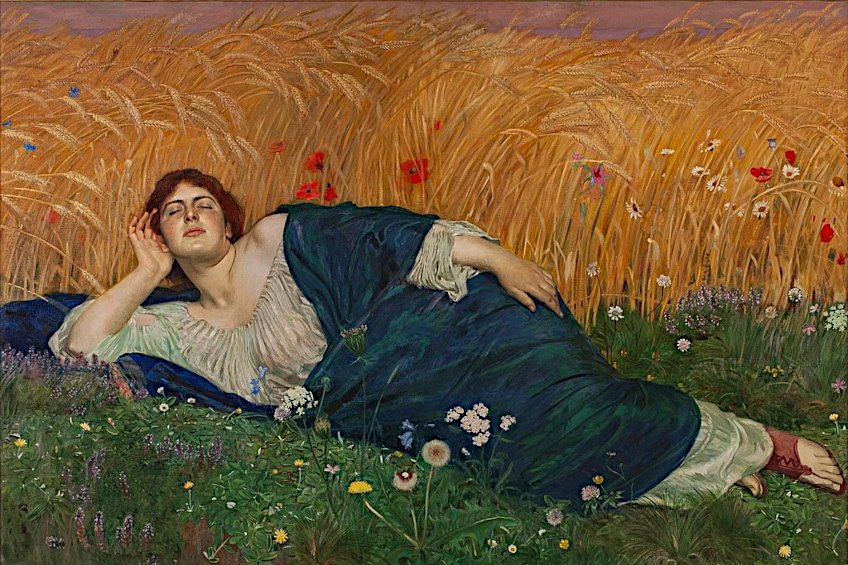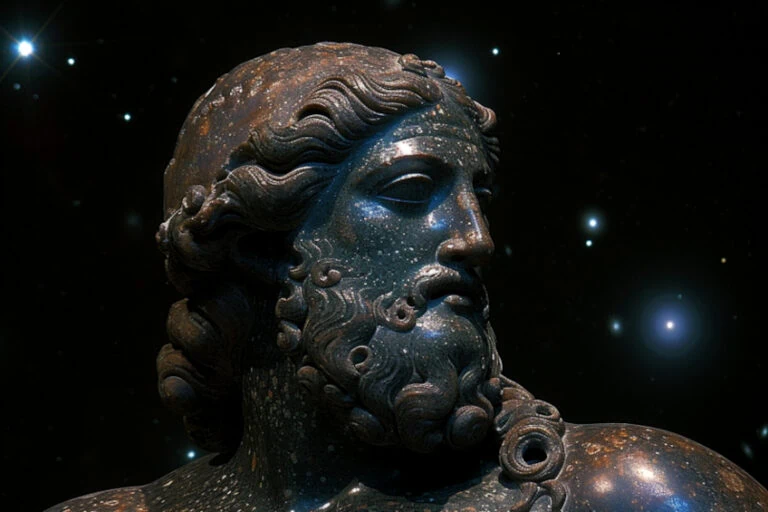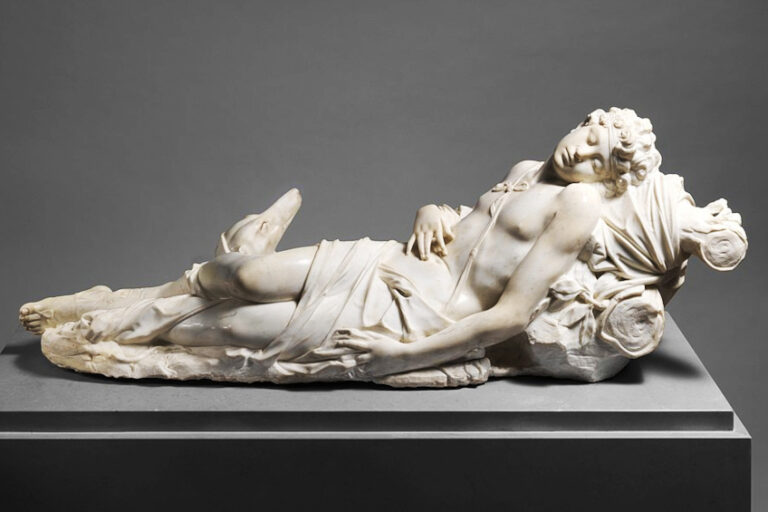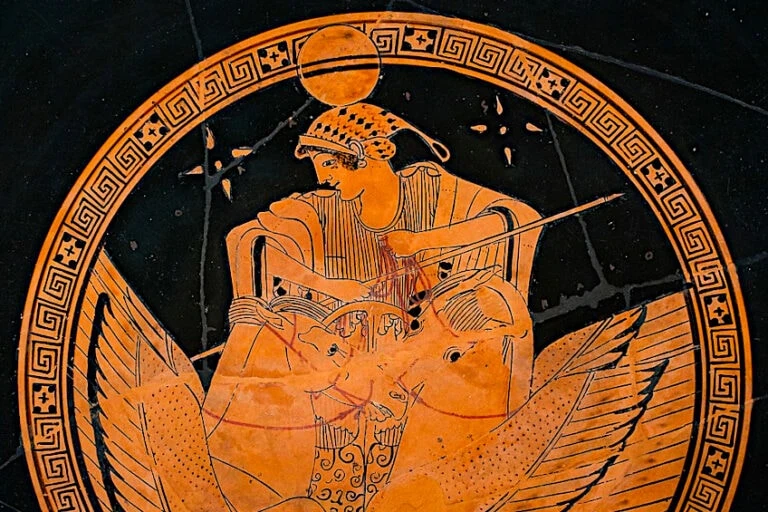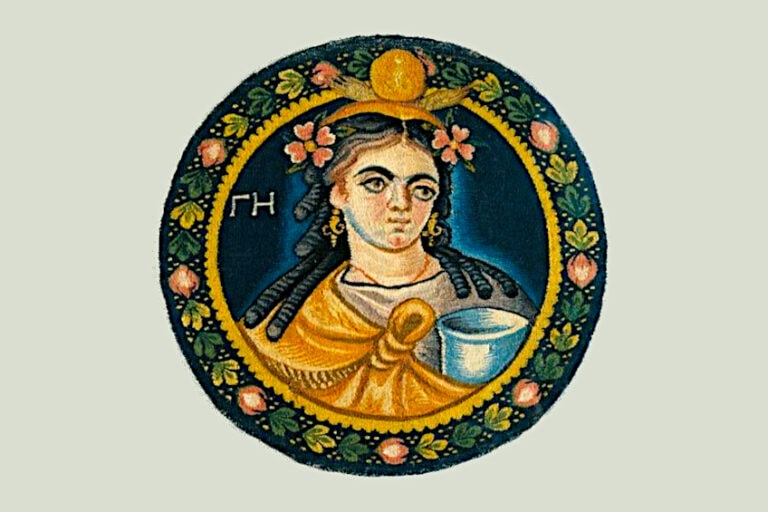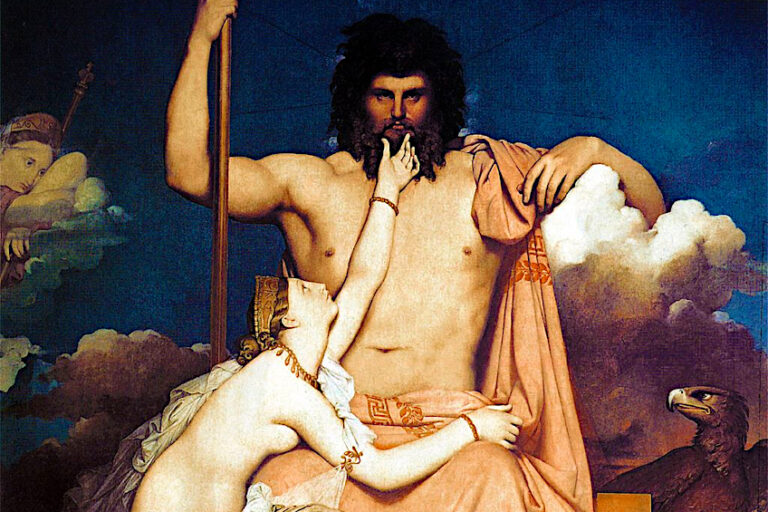Greek Goddess Demeter – Guardian of Grain Crops and Fertility
What is Demeter the goddess of and what is Demeter known for? The Greek goddess Demeter is known in ancient Greek mythology as the goddess of agriculture. She presided over crops and the earth’s fertility, and her domain of influence also included birth, health, and marriage. Let’s find out more about Demeter’s personality, and answer questions relating to the Greek goddess Demeter, such as “is Demeter Zeus’ sister?”, and “what is Demeter’s Roman name?”.
Contents
What Is Demeter the Divinity Of?
| Name | Demeter |
| Gender | Female |
| Personality | Loving, nurturing, and generous |
| Parents | Chronos and Rhea |
| Siblings | Hera, Hestia, Hades, Poseidon, and Zeus |
| Children | Persephone, Plutus, the horse Arion, Despoena, and Iacchus (also her husband in some myths) |
| Domain | Harvest, agriculture, birth, health, and marriage |
| Symbols | Cornucopia, torch, wheat, poppy, and bread |
Demeter initially emerged as the ancient Greek goddess of grain and harvesting, but her responsibilities and influence eventually spread beyond the cornfields, and she was regularly associated with Gaia, the earth goddess. Some of Demeter and Gaia’s epithets are similar, emphasizing their shared attributes.
Through her daughter Persephone, Demeter was also associated with the Underworld and Chthonic cults such as the secret rites of the famous Eleusinian mysteries.
 Votive figurine of Demeter (520-500 BCE); © José Luiz Bernardes Ribeiro
Votive figurine of Demeter (520-500 BCE); © José Luiz Bernardes Ribeiro
Demeter and Persephone share the dual responsibility of presiding over fertility and death. The Greek goddess Demeter is regarded as the provider of the secret rites as well as the provider of the fundamentals of grain production. She was sometimes associated with Rhea Cybele, the Great Mother, who was worshiped in Asia Minor and Crete with music and violent rituals. Poppies appear to have been associated with this Great Mother’s cult, suggesting ritual opiate use.
Background and Family of Demeter
Eleusis’ sanctuary is devoted to both the Greek goddess Demeter and her daughter Persephone. The renowned Eleusinian Mysteries took place here. From Eleusis, the belief that Demeter would watch over her devotees in the afterlife propagated across the Archaic Greek realm. The deity remained popular among the Romans, who called her Ceres.
Demeter’s Family
Demeter was Chronos and Rhea’s second child. Chronos swallowed her as a baby because of his belief that one of his offspring would one day overthrow him; she was released when her youngest brother Zeus forced Chronos to disgorge every one of his offspring by getting him to drink a magical potion.
Demeter is best known as the mother of Persephone, the ‘goddess daughter by her brother Zeus.
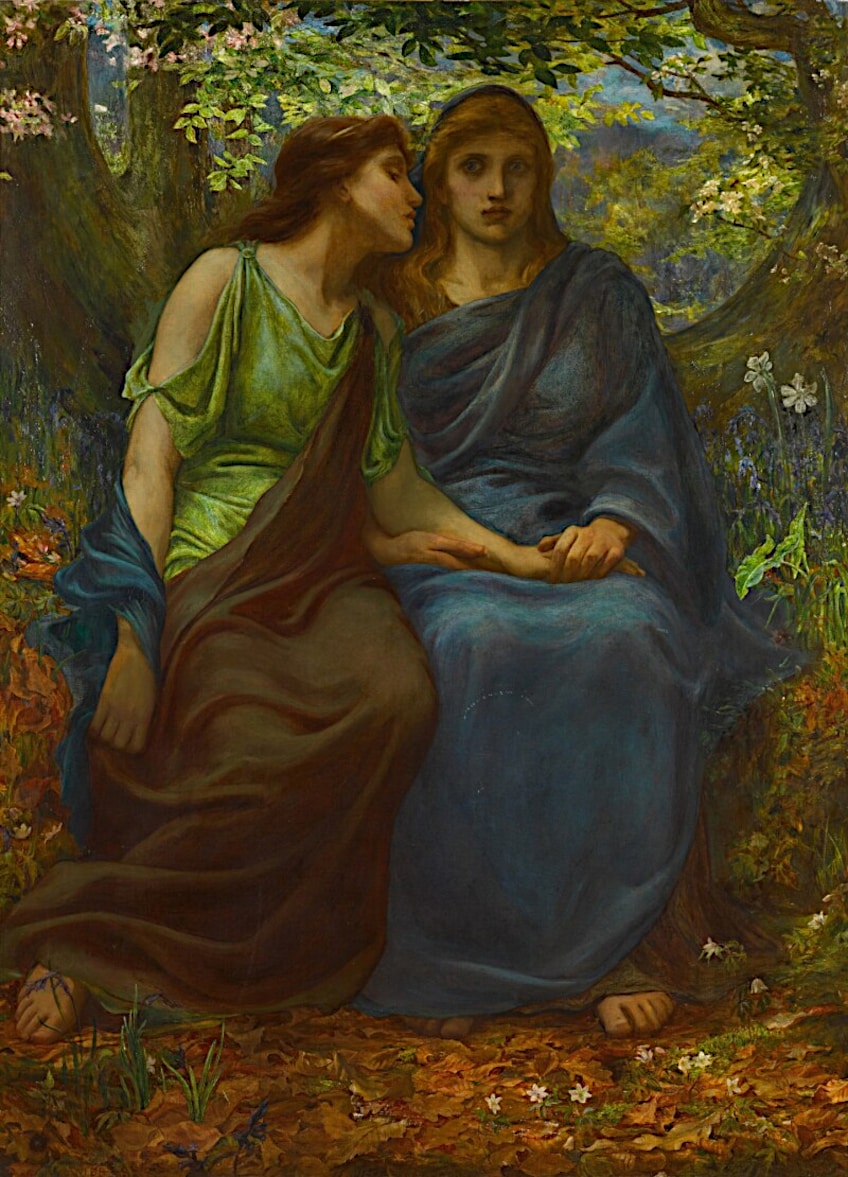 Demeter and Persephone by John D. Batten (1891); John D. Batten, Public domain, via Wikimedia Commons
Demeter and Persephone by John D. Batten (1891); John D. Batten, Public domain, via Wikimedia Commons
Persephone
In most myths, Zeus and Demeter were siblings and they had one daughter named Persephone. An alternative version of the story comes from a small fragment of an otherwise lost Orphic theogony, which contains part of an account in which Zeus sleeps with his mother, Rhea, in the guise of a snake, revealing the story behind the creation of the image on Hermes’ staff. Their daughter is considered to be Persephone, with whom, Zeus then slept to produce Dionysus.
According to these ancient Orphic texts, “after becoming Zeus’ mother, she who was previously Rhea then became known as Demeter”.
Persephone was commonly referred to as Kore before being kidnapped by Hades, and there is substantial indication that the characters of the Queen of the Underworld, Persephone, and the daughter of Demeter, Kore, were first regarded as different deities. They must, however, have become confused with each other by Hesiod’s time in the seventh century BCE. Persephone and Demeter were often worshiped together and were given shared cultic titles.
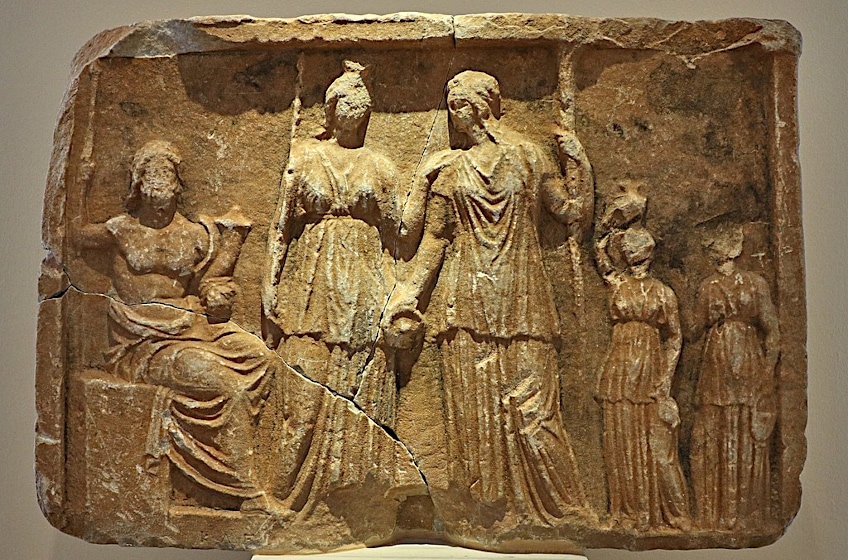 Plaque depicting Plutus, with Persephone, Demeter and two female worshippers (late 4th to early 3rd Century BCE); George E. Koronaios, CC BY-SA 4.0, via Wikimedia Commons
Plaque depicting Plutus, with Persephone, Demeter and two female worshippers (late 4th to early 3rd Century BCE); George E. Koronaios, CC BY-SA 4.0, via Wikimedia Commons
Hesiod and Homer both report that during Harmonia and Cadmus’ wedding, Demeter conceived the god of wealth Plutus with Iason in a plowed field.
Dionysus
According to Diodorus Siculus, Zeus and Demeter were also Dionysus’ parents. Diodorus detailed Dionysus’ dual birth story (once from the ground and another time from the vine).
Diodorus additionally related an account of Dionysus being cooked by the Titans and Demeter gathering up his remnants so that he may be born a third time.
According to Diodorus, Dionysus’ birth from the King of the gods and his sister Demeter was not common belief, and possibly reflect an erroneous identification of Demeter with her daughter, as most sources indicate Dionysus’ parents were Persephone and Zeus, and then subsequently Semele and Zeus.
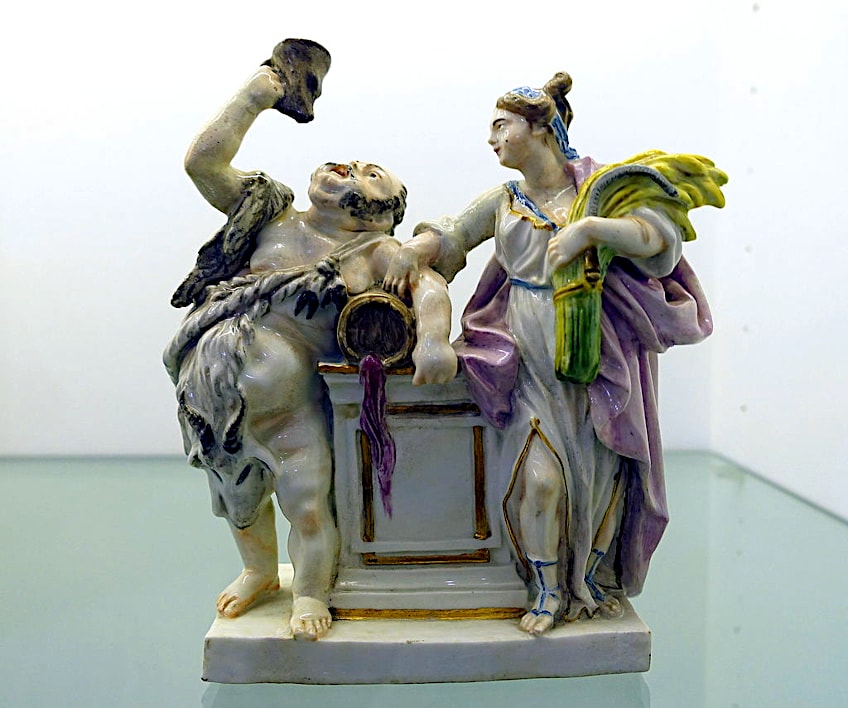 Porcelain figurines of Demeter and Dionysus produced by Real Fábrica del Buen Retiro (1783-1803); Daderot, Public domain, via Wikimedia Commons
Porcelain figurines of Demeter and Dionysus produced by Real Fábrica del Buen Retiro (1783-1803); Daderot, Public domain, via Wikimedia Commons
Despoena
Despoena, an important Arcadian divinity, was thought to be the daughter of Poseidon and Demeter. Poseidon went in pursuit of Demeter while she was looking for Persephone, according to a Thelpusian legend. To evade her brother’s advances, Demeter transformed herself into a horse. Poseidon, though, also transformed into a horse and coupled with Demeter, who later give birth to the horse deity Arion and a daughter named Despoena.
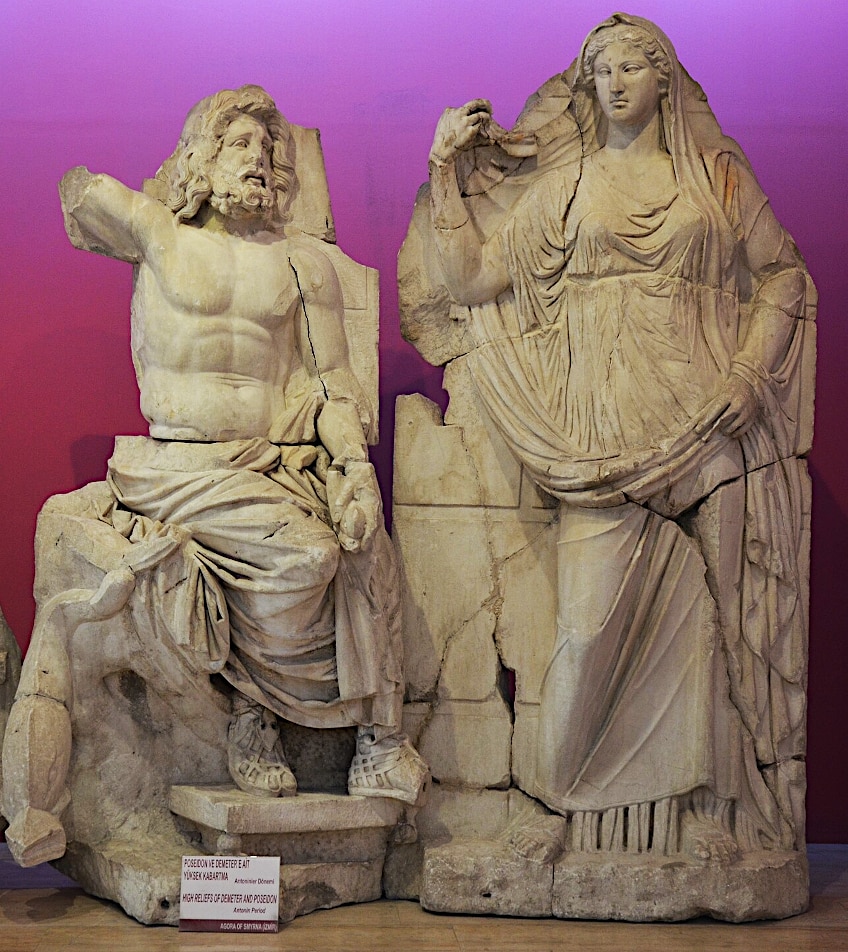 Demeter and Poseidon (mid 2nd Century CE); Carole Raddato from FRANKFURT, Germany, CC BY-SA 2.0, via Wikimedia Commons
Demeter and Poseidon (mid 2nd Century CE); Carole Raddato from FRANKFURT, Germany, CC BY-SA 2.0, via Wikimedia Commons
While “despoena” meaning “the mistress” was a cult epithet of the goddesses Demeter, Persephone, and Aphrodite, in Arcadia she was worshiped as a distinct deity.
Demeter’s Personality and Attributes
The Greek goddess Demeter is a multifaceted and powerful deity with a unique personality. Demeter is portrayed as a loving and motherly deity. She is profoundly concerned about the health of the land, plants, and all living things. Her status as the goddess of agriculture demonstrates her devotion to cultivating agricultural growth and providing abundant harvests.
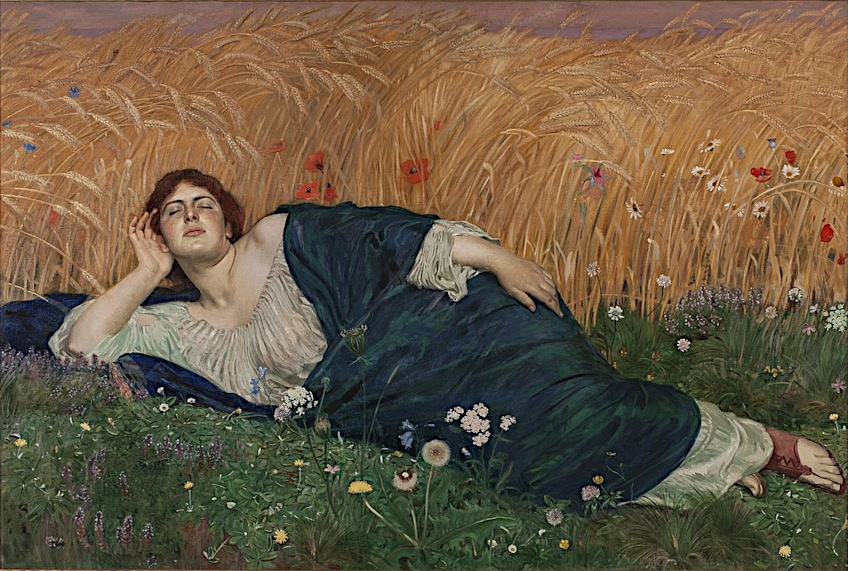 Ceres (Demeter) by Osmar Schindler (between 1900 and 1903); Osmar Schindler, Public domain, via Wikimedia Commons
Ceres (Demeter) by Osmar Schindler (between 1900 and 1903); Osmar Schindler, Public domain, via Wikimedia Commons
She personifies motherhood and is connected with fertility, both in terms of agriculture and humans. Demeter passionately guards her territory and those in her charge.
The Symbols and Attributes of Demeter
Demeter can be identified with a number of symbols that signify her realms and qualities. Demeter’s most significant symbols are grain and wheat. They symbolize fertility and abundant harvests. Demeter’s function as the goddess of agriculture is inextricably linked to these symbols because she assures crop growth and yield.
The cornucopia, commonly referred to as the “horn of plenty”, is another Demeter-related symbol. It’s a horn-shaped container brimming with vegetables, fruits, and other earthly bounty. The cornucopia signifies the abundance and success that Demeter provides agriculture through her blessings.
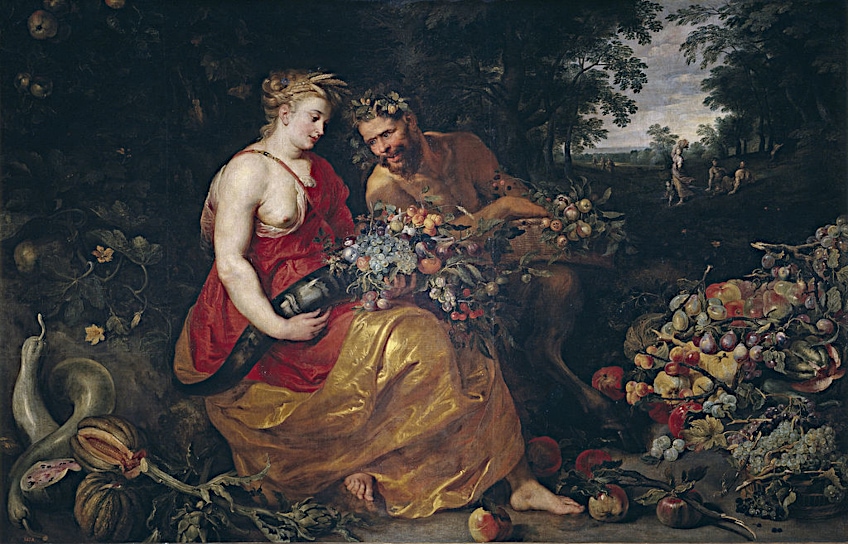 Ceres and Pan by Peter Paul Rubens and Frans Snyders (1615 / c.1620); Frans Snyders, Public domain, via Wikimedia Commons
Ceres and Pan by Peter Paul Rubens and Frans Snyders (1615 / c.1620); Frans Snyders, Public domain, via Wikimedia Commons
The poppy flower is important in Demeter’s mythology. Demeter journeyed in sadness after her daughter was abducted, and it claimed that during this time that she swallowed a poppy drink, which provided her with brief comfort from her grief. The poppy has a strong connection with comfort and the ephemeral quality of happiness. Demeter is sometimes seen holding a torch, which represents her quest for her daughter. The torch signifies Demeter’s tenacity and her constant dedication to finding Persephone and lighting her way.
Because of their link to the ground and fertility, snakes are also often identified with the Greek goddess Demeter.
Snakes symbolize rebirth and the life cycle. In other portrayals, Demeter is accompanied by or carries a snake as a sign of her dominion over the fertility of the earth. The sickle is an agricultural instrument used for harvesting. Demeter is sometimes seen carrying a sickle, symbolizing her function as the harvest goddess and her capacity for bringing forth the earth’s bounty.
Marcus Manilius assigns Demeter the zodiac constellation Virgo, the Virgin, in his 1st-century Roman treatise Astronomicon. Virgo appears near the constellation Leo the Lion, holding a sheaf of wheat.
Physical Description in Literature and Art
Demeter was depicted as a mature and majestic goddess in ancient Greek art and literature. The Greek goddess was portrayed as a motherly goddess who exudes affection and compassion and was often shown with a kind expression, illustrating her maternal personality. She is generally depicted with a solemn yet serene appearance.
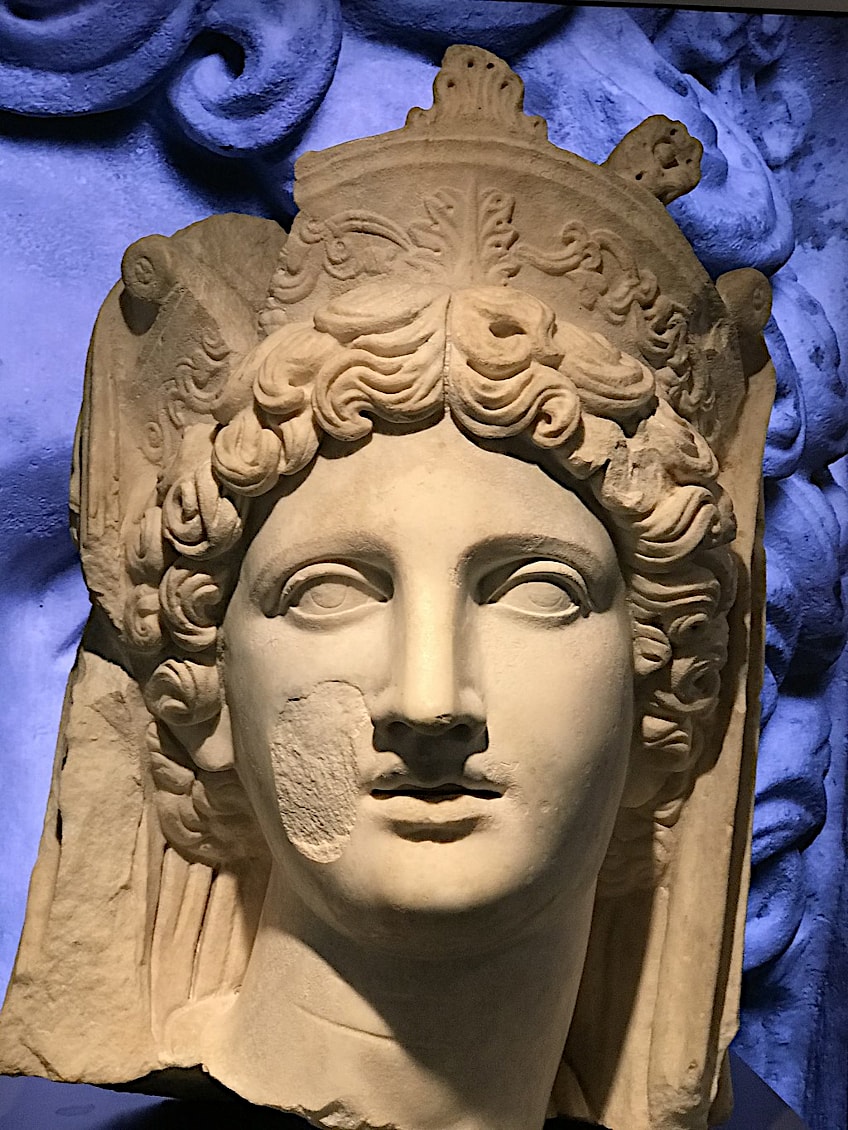 Head of a statue of Demeter (2nd Century CE); Bodrumlu55, CC BY-SA 4.0, via Wikimedia Commons
Head of a statue of Demeter (2nd Century CE); Bodrumlu55, CC BY-SA 4.0, via Wikimedia Commons
Demeter is usually portrayed with her long wavy hair adorned with wreaths, ears of wheat, or flowers and a the veil worn by married women.
Demeter is usually wearing a flowing garment that covers her entire body modestly. She is often shown carrying wheat stalks, sickles, or ears of grain. This symbolizes her function as the goddess of agriculture and harvest, demonstrating her relationship with abundance and fertility.
Demeter’s Domain of Influence
What is Demeter the god of? Demeter is known as the Corn-Mother in the Theogony, the goddess of cereals who offers the grain needed for making bread and her role is to bless its harvesters. In Iliad by Homer, Demeter helps separate the grain from the chaff with the assistance of the wind. Homer talks about the Thalysia, a Greek harvest celebration commemorating Demeter. Prayers to chthonic Zeus and Demeter, according to Hesiod, generated crops that grew full and robust. The majority of Demeter’s epithets refer to her as a goddess of grain.
In literature, her name Deo is most likely related to deai, a Cretan word meaning cereal. According to the oldest belief about Demeter as the Corn mother, she was known as Haloas in Attica.
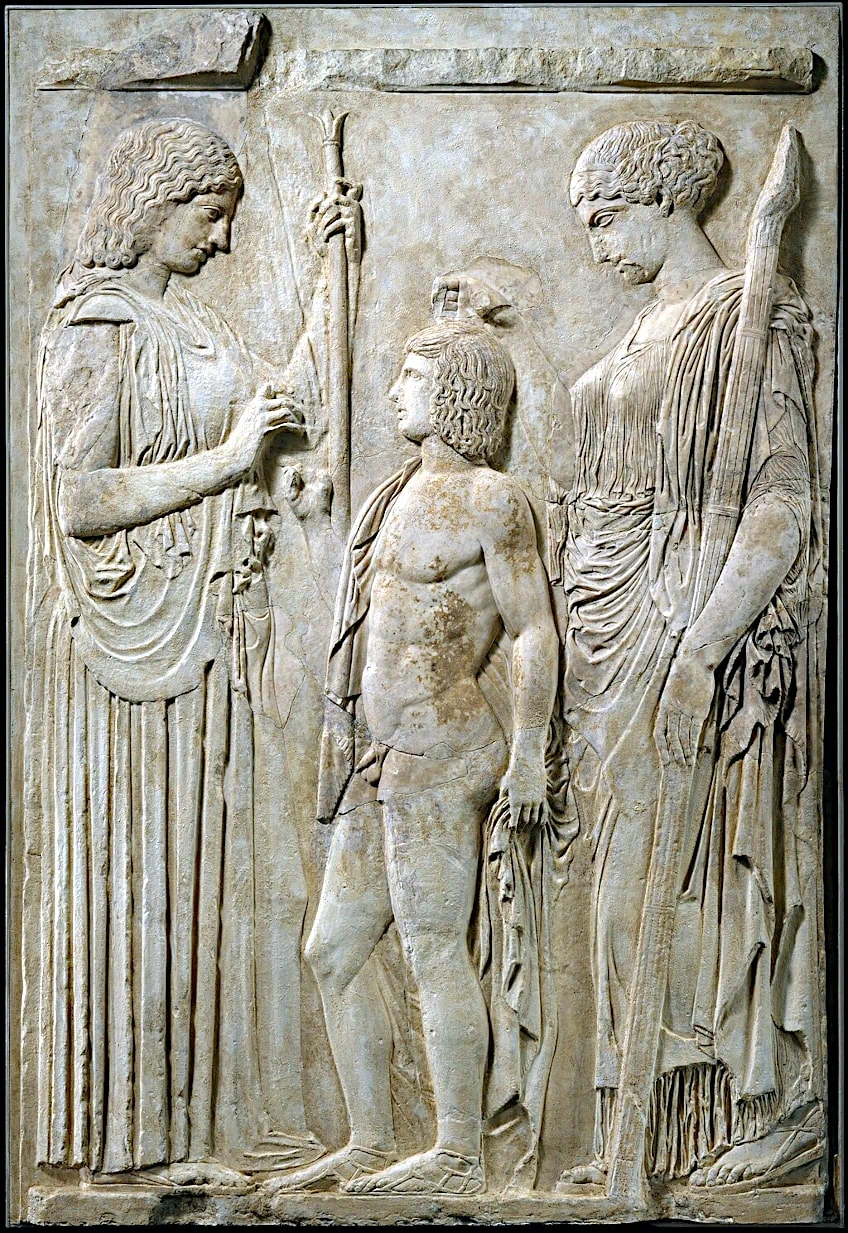 Relief from Eleusis depicting Triptolemus between Persephone and Demeter (c. 27 BCE-14 CE); Metropolitan Museum of Art, CC0, via Wikimedia Commons
Relief from Eleusis depicting Triptolemus between Persephone and Demeter (c. 27 BCE-14 CE); Metropolitan Museum of Art, CC0, via Wikimedia Commons
She was also known as Chloe, the goddess of new corn and vegetation. The reunion of Persephone and Demeter, when the new crops were united with the old seed, was the fundamental motif of the Eleusinian Mysteries and was seen as a representation of eternity. According to Isocrates, Demeter’s greatest gifts to humanity were agriculture, which endowed humans with a civilized way of life, and the Mysteries, which provided initiates with greater hope in this life and the hereafter.
In Demeter’s tales and mystery cults, these two gifts were inextricably linked when she teaches agriculture and her sacred mysteries to the hero Triptolemus.
Goddess of the Earth and Underworld
The Greek goddess Demeter, in addition to her position as an agricultural goddess, was also worshiped as an Earth goddess, from which crops grow. Her distinctiveness had its roots in Gaia’s less-developed personality. The Black Demeter appeared in Arcadia as snake-haired with the head of a horse, clutching a dolphin and a dove, possibly to reflect her dominion over the Underworld, the sea, and the air. She was referred to as Chthonic Demeter in Sparta. Every death was followed by a sacrifice to the deity.
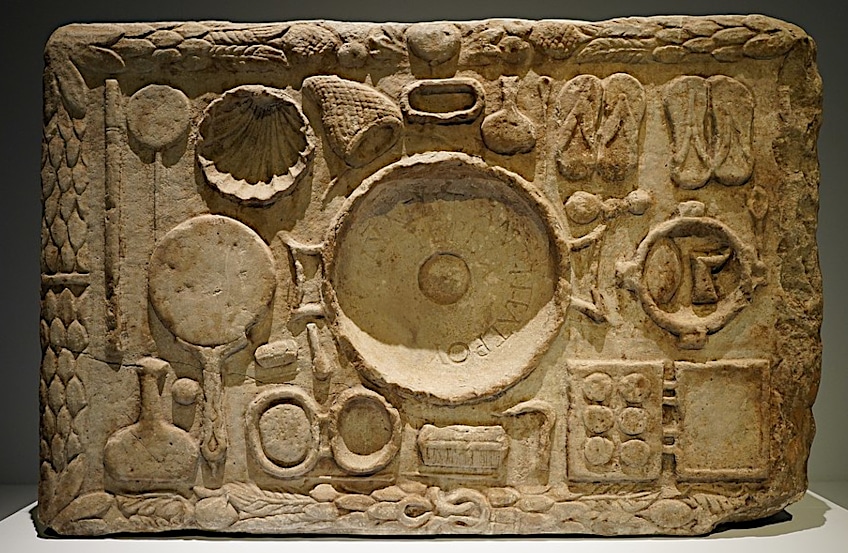 Votive panel with depictions of gifts dedicated by Claudia Ageta, a priestess of Demeter to the goddess (170 CE); TimeTravelRome, CC BY 2.0, via Wikimedia Commons
Votive panel with depictions of gifts dedicated by Claudia Ageta, a priestess of Demeter to the goddess (170 CE); TimeTravelRome, CC BY 2.0, via Wikimedia Commons
According to Pausanias, her cult had been introduced by Hermione, wherein Demeter became synonymous with Hades.
According to local tradition, a hollow in the earth was the gateway to the underworld, through which spirits could effortlessly transit. In archaic Chthonic worship related to the descent to Hades, she was known as Demeter-Chamyne in Elis. At Levadia, the goddess became associated with Trophonius, an ancient underworld deity whose oracle was well-known in antiquity. The deceased were known as the “Demetrioi” by the Athenians, and this could indicate a relationship between Demeter and the ancient religion of the dead, which was based on the agricultural concept that a new life would grow from the dead body, much as a new plant emerges from the buried seed.
The Mythology of the Greek Goddess Demeter
Above, we touched a bit on a few of Demeter’s myths regarding her daughter, Persephone. We will now go further into that myth as well as several other significant Greek myths relating to Demeter. Let’s begin with the story of Persephone’s abduction.
Persephone’s Abduction
In this myth, Hades kidnapped Demeter’s daughter Persephone and carried her away to the Underworld after obtaining consent from Zeus, her father. The Greek goddess Demeter spent nine days searching for her, completely consumed with her sadness. Hecate then met with her, saying that while she hadn’t witnessed what had happened to Persephone, she had noticed her screaming. Both of the goddesses went to the sun god, Helios, who had an elevated position from which to see all that took place on Earth. Helios then told the goddess Demeter that Hades had kidnapped Persephone with the approval of Zeus, with the intent of making her his bride in the Underworld.
Demeter got furious as a result, and essentially went on strike. The seasons came to a standstill, and all living things stopped growing and started to perish. Faced with the annihilation of all life on Earth, Zeus sent Hermes to Hades to retrieve Persephone.
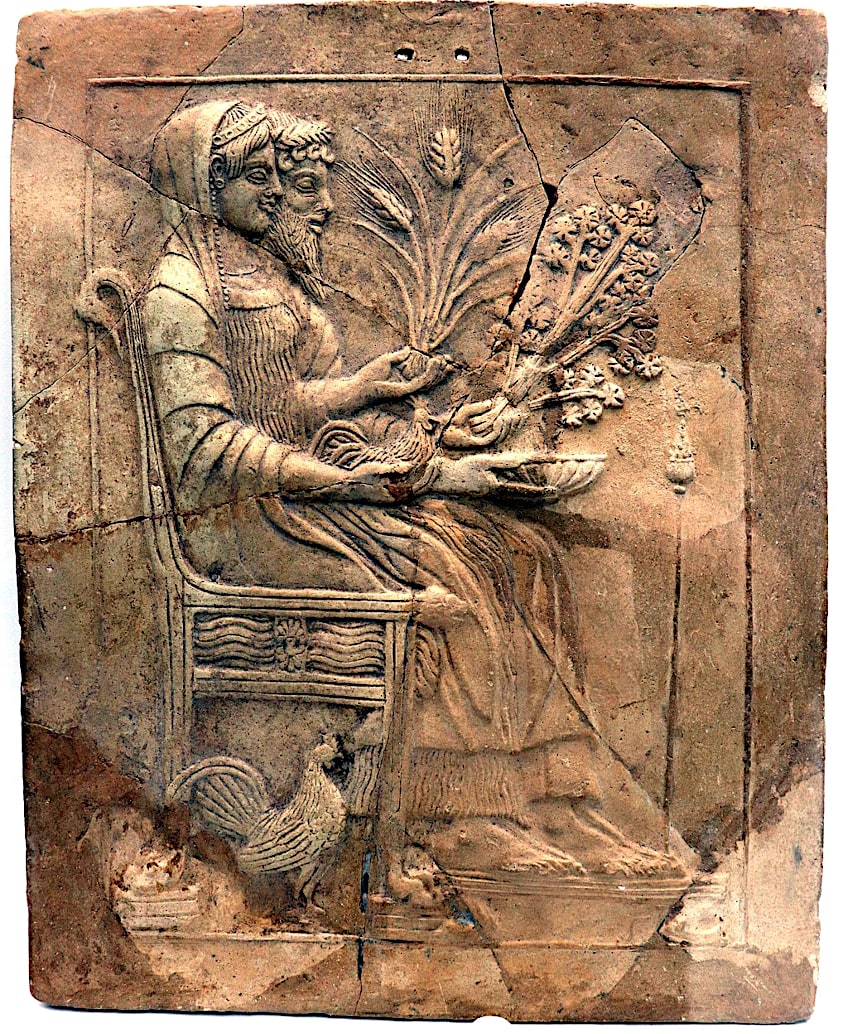 Plaque depicting Hades and Persephone (500-450 BCE); National Museum of Magna Græcia, CC BY-SA 4.0, via Wikimedia Commons
Plaque depicting Hades and Persephone (500-450 BCE); National Museum of Magna Græcia, CC BY-SA 4.0, via Wikimedia Commons
Hades agreed to let her go if she didn’t consume anything while in his domain, but Persephone had eaten a few pomegranate seeds. This meant that she was bound to Hades in the Underworld for specific months of the year. Contrary to common belief, Persephone’s stay in the Underworld does not match with the barren months of the ancient Greek calendar, nor does her journey back to the world above coincide with springtime. The Eleusinian Mysteries are connected to Demeter’s descent into the Underworld.
The tale of Persephone’s abduction appears to be pre-Greek. Ploutos signify the riches of maize kept in subterranean silos or ceramic jars in the Greek version. Similar underground jars were utilized for burial purposes in ancient times.
Demeter at Eleusis
Demeter’s pursuit of Persephone led her to the King of Eleusis in Attica. She pretended to be an elderly woman and pleaded for sanctuary. He brought her in to nurse his sons with Metanira, Triptolemus and Demophon.
Demeter intended to make Demophon immortal as a reward for his compassion; she covertly anointed the child with ambrosia and placed him in the hearth’s flames in order to slowly burn away his mortal existence.
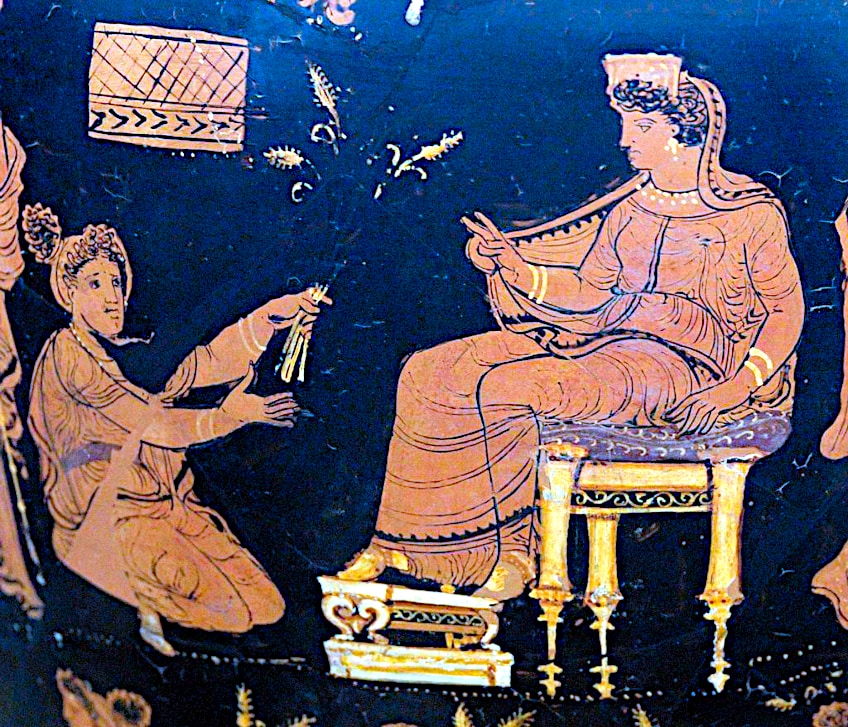 Apulian red-figure hydria featuring a depiction of Demeter and Metaneira (c.340 BCE); Altes Museum, Public domain, via Wikimedia Commons
Apulian red-figure hydria featuring a depiction of Demeter and Metaneira (c.340 BCE); Altes Museum, Public domain, via Wikimedia Commons
Metaneira, though, arrived, saw her young child in the fire, and screamed in terror. Demeter gave up on her endeavor. However, she taught Triptolemus the techniques of agriculture, which he then passed on to anybody who was interested. As a result, mankind learned to plant, cultivate, and harvest grain. There are various versions of the tale, some of which are associated with individuals such as Rarus, Eleusis, and Trochilus.
Demeter and Erysichthon
The tale of Erysichthon, ruler of Thessaly, also involves Demeter’s fury causing famine. The story relates how Erysichthon ordered the destruction of all the trees in one of Demeter’s holy groves in order to construct an expansion of his royal residence and host feasts there. Erysichthon’s workers refused to chop down one tree, a massive oak since it was draped in votive wreaths, symbolic of the requests Demeter had granted. The monarch hacked it down with an ax, murdering a dryad nymph in the process of doing so. Erysichthon was cursed by the nymph’s last words.
Demeter chastised the monarch by summoning Limos, the personification of insatiable hunger, to inhabit his stomach. The more the king ate, the hungrier he became.
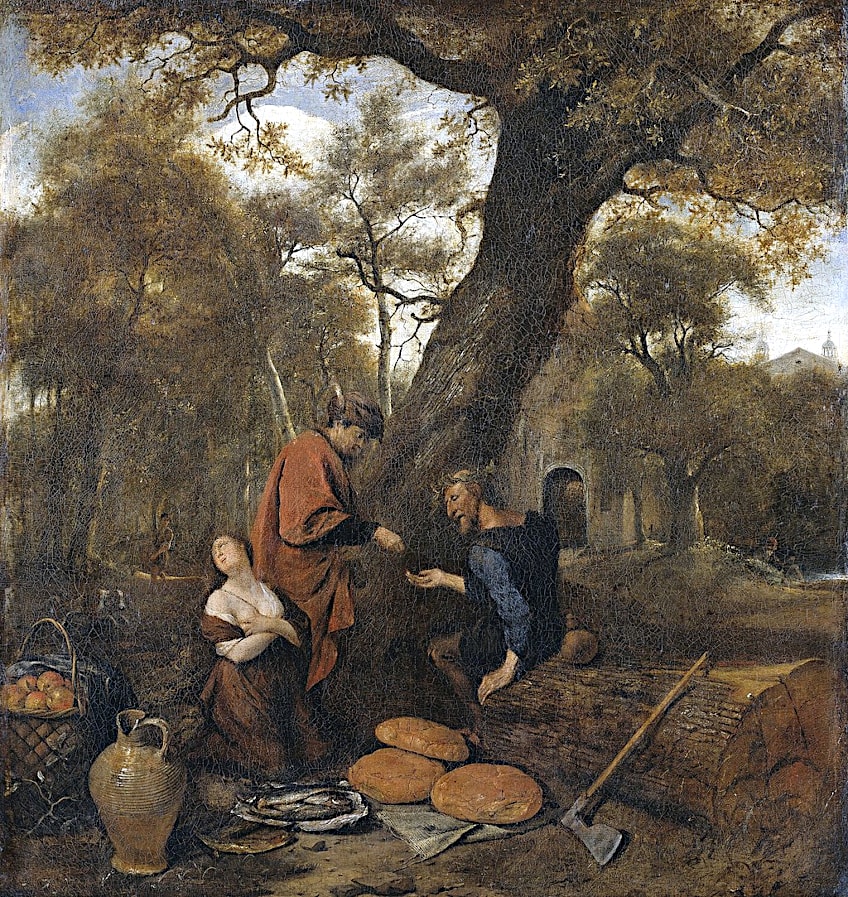 Eryschthon Selling his Daughter Mestra by Jan Steen (between 1650 and 1660); Jan Steen, Public domain, via Wikimedia Commons
Eryschthon Selling his Daughter Mestra by Jan Steen (between 1650 and 1660); Jan Steen, Public domain, via Wikimedia Commons
Erysichthon sold everything he owned to purchase food, yet he was still hungry. He eventually sold Mestra, his daughter, into slavery. Poseidon, Mestra’s previous lover, released her from servitude by bestowing upon her the ability to shape-shift into any living thing in order to break free from her bindings. Erysichthon sold her shape-shifting skill several times to get more money to sustain himself, but no quantity of food was sufficient. Erysichthon eventually ate himself to death.
In another version, Erysichthon demolished a Demeter shrine in order to create a roof for his house; so the goddess punished him and sent a snake to harass him.
Demeter then placed him among the stars, like she did the serpent, to continue to torment Erysichthon. The Pergamon Altar, which portrays the battle of the Olympians against the Giants, has the remnants of what appears to be Demeter battling a Giant named “Erysichthon”. In the Suessula Gigantomachy vase, which is now displayed in the Louvre Museum, Demeter is also seen fighting against the Giants alongside Hermes.
Myths of Wrath Involving Demeter
Demeter arrived in Attica tired after traveling far and wide in search of her daughter. Because it was a scorching day, a woman named Misme took her in and provided her a cup of water with barley and pennyroyal groats. Demeter sipped the cup hastily due to thirst. Misme’s son, Ascalabus, laughed, teased her, and asked if she wanted a large jar for the drink.
Demeter proceeded to pour the drink over him, transforming him into a gecko, which both mortals and gods despised. It was thought that Demeter favored people who killed geckos.
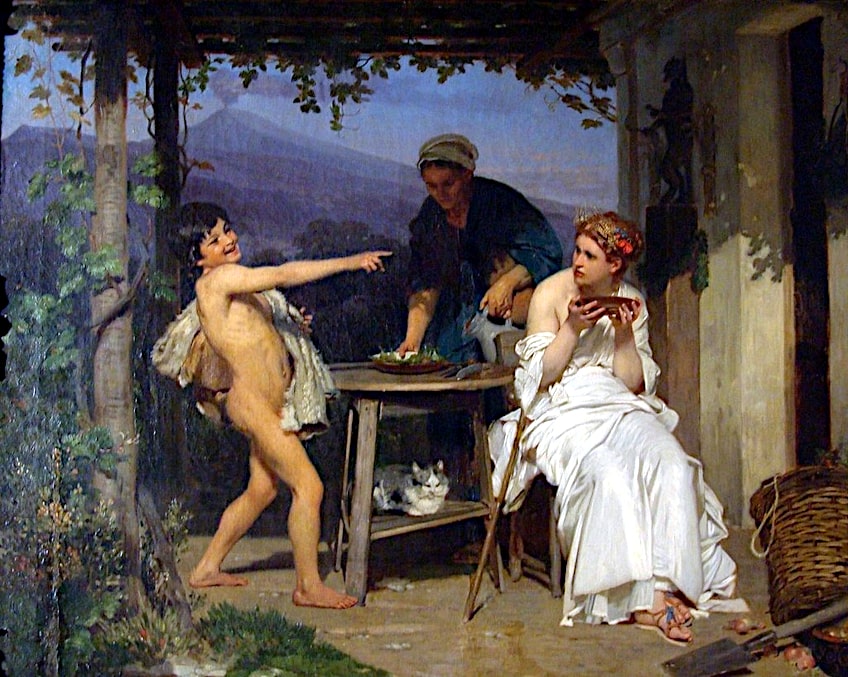 Ceres mocked by Ascabalos by Eugène Ernest Hillemacher (1877); Eugène Ernest Hillemacher, Public domain, via Wikimedia Commons
Ceres mocked by Ascabalos by Eugène Ernest Hillemacher (1877); Eugène Ernest Hillemacher, Public domain, via Wikimedia Commons
Hades had kept Minthe the nymph as his mistress before abducting Demeter’s daughter. However, after marrying Persephone, he abandoned Minthe. She would often boast that she was more beautiful than Persephone and that Hades was going to return to her and remove Persephone from his halls. Demeter became enraged and stepped on Minthe, resulting in the emergence of a lovely-smelling plant named after the nymph.
In some versions of the myth, Persephone is actually the one who murders Minthe and changes her into a plant in order to win the affections of Hades.
Myths of Favor Involving Demeter
Demeter handed Triptolemus her chariot that was drawn by serpents and seeds, instructing him to disperse them throughout the land (educate humanity about agriculture). Triptolemus traveled through Asia and Europe until he arrived in the territory of Lyncus, a Scythian monarch. Lyncus pretended to provide him the usual hospitality, but when Triptolemus fell asleep, he stabbed him with a blade, hoping to claim credit for his efforts. Demeter subsequently rescued Triptolemus by transforming Lyncus into a lynx and ordering Triptolemus to fly home.
In the story of Psyche and Eros, Demeter and Hera suggested that Aphrodite was wrong to condemn her son’s infatuation with his human lover.
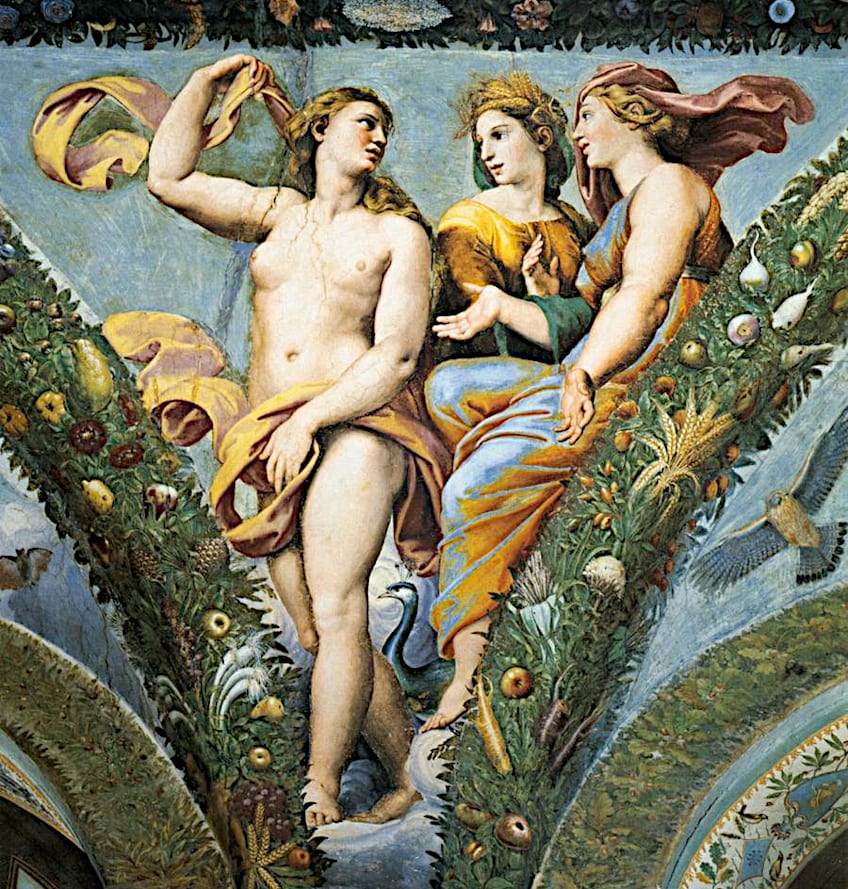 Venus, Ceres, and Juno (Aphrodite, Demeter, and Hera) by Raphael (between 1517 and 1518); Raphael, Public domain, via Wikimedia Commons
Venus, Ceres, and Juno (Aphrodite, Demeter, and Hera) by Raphael (between 1517 and 1518); Raphael, Public domain, via Wikimedia Commons
Aphrodite was offended by their statements. Later, while wandering in search of Eros, Psyche stumbled into an abandoned Demeter temple and went through the abandoned sickles and harvest equipment she discovered. Demeter came to her and called from afar, warning her of Aphrodite’s immense fury and her plot to get revenge on her. Then Psyche implored Demeter to rescue her, but Demeter said that she couldn’t intervene and risk provoking Aphrodite’s wrath any further, so Psyche had to leave or be held hostage in her temple.
That completes today’s exploration of the Greek goddess Demeter. In Greek mythology, Demeter is the daughter of the gods Chronos and Rhea, the sister and lover of Zeus, and is regarded as the goddess of agriculture. Demeter was most often depicted as a grain goddess. The name Loulo has been interpreted as linking her with the sheaf and demonstrating that the Demeter religion began with the adoration of the grain mother. Demeter’s authority, though, was not restricted to grain but extended to all flora and all fruits of the land, save the bean. In that respect, Demeter was similar to Gaia, with whom she shared some epithets, and was on occasion equated with Cybele, the Great Mother of the Gods.
Frequently Asked Questions
What Is Demeter the Goddess Of?
Demeter was one of the most ancient goddesses in the Greek pantheon. Known as Corn-Mother, she was a goddess of agriculture who ensured the earth’s productivity. She protected both agriculture and fertility. Demeter inherited her mother Rhea’s intimate relationship with the earth. The Greek goddess Demeter was most likely a reincarnation of local mother Earth deities that were worshiped in Bronze Age Greece’s rural settlements. However, her domain of influence extended beyond crops to include birth, marriage, and health.
What Is Demeter Known For?
Demeter is directly linked to agriculture and cultivating land. She is in charge of the earth’s fertility, promoting agricultural development and a bounty of harvests. Ancient Greek farmers sought Demeter’s blessings and protection to guarantee abundant crops. Demeter’s effect on agriculture extended to the seasonal cycles. Demeter’s grief is thought to have caused the earth to wilt and endure a state of endless winter when her daughter Persephone was taken by Hades. The ground bloomed anew, heralding the advent of spring and summer, only after Persephone was permitted to reside for part of the year with Demeter. Demeter’s dominion over the seasons illustrates the link between agriculture and the earth’s natural cycles.
What Is Demeter’s Roman Name?
Ceres is Demeter’s Roman equivalent. Ceres, like Demeter in Greek mythology, is the deity of fertility, agriculture, and harvest in Roman mythology. Many components of Greek mythology were absorbed by the Romans, who often connected their own deities with their Greek counterparts, but gave them different names. Both goddesses were also associated with a mother Goddess from Asia Minor known as Cybele.
Is Demeter Zeus’ Sister?
Yes, Zeus is Demeter’s brother. However, he also happens to be the father of the most famous of Demeter’s children, Persephone, who Demeter’s other brother Hades kidnapped and took away to the Underworld. In Hades’ defense, he did so after Zeus gave him permission to make Persephone his bride. This enraged Persephone’s mother, Demeter, who went to get her daughter back, leaving the earth barren until a compromised was reached that allowed Persephone to return to the world of the living for a few months (winter) every year.

I am deeply passionate about history and am constantly fascinated by the rich and complex stories of the past. As the editor-in-chief of learning-history.com, I have the opportunity to share this passion with a wide audience through the creation and distribution of engaging and informative content about historical events, persons, and cultures. Whether it’s through writing articles and blog posts or creating videos or podcasts, I strive to bring the past to life in a way that is both accurate and enjoyable. My expertise in history, combined with my strong writing and communication skills, allows me to effectively communicate complex historical concepts and make them accessible and interesting to a wide range of readers. I am truly grateful for the opportunity to share my love of history with others through my work on learning-history.com.

